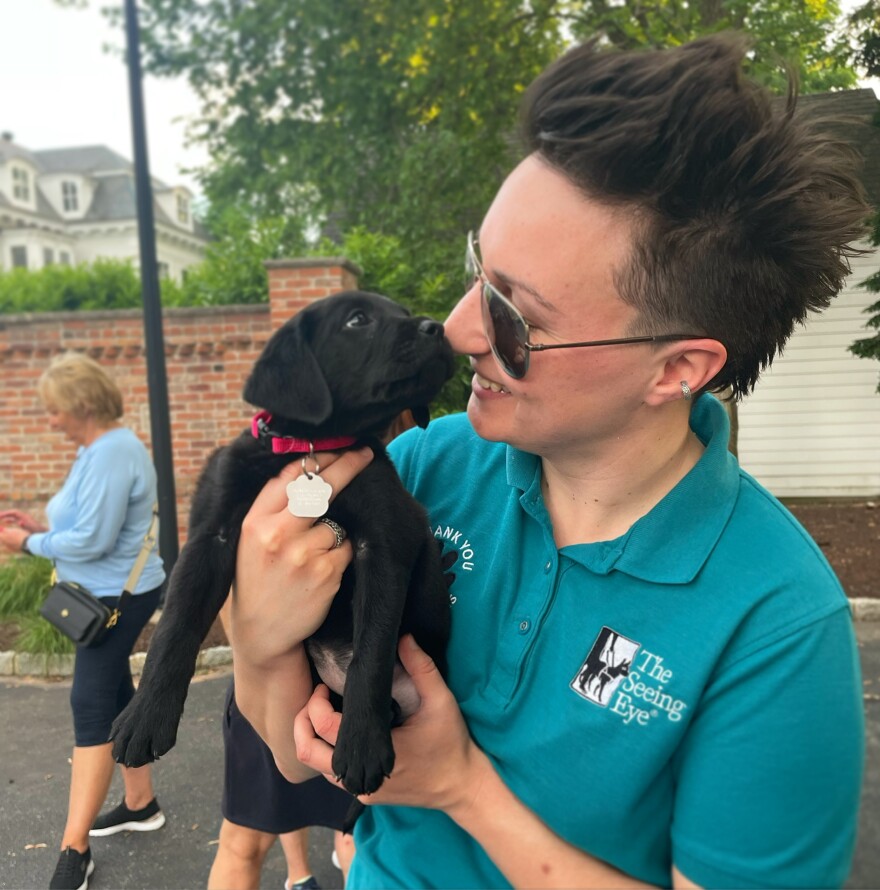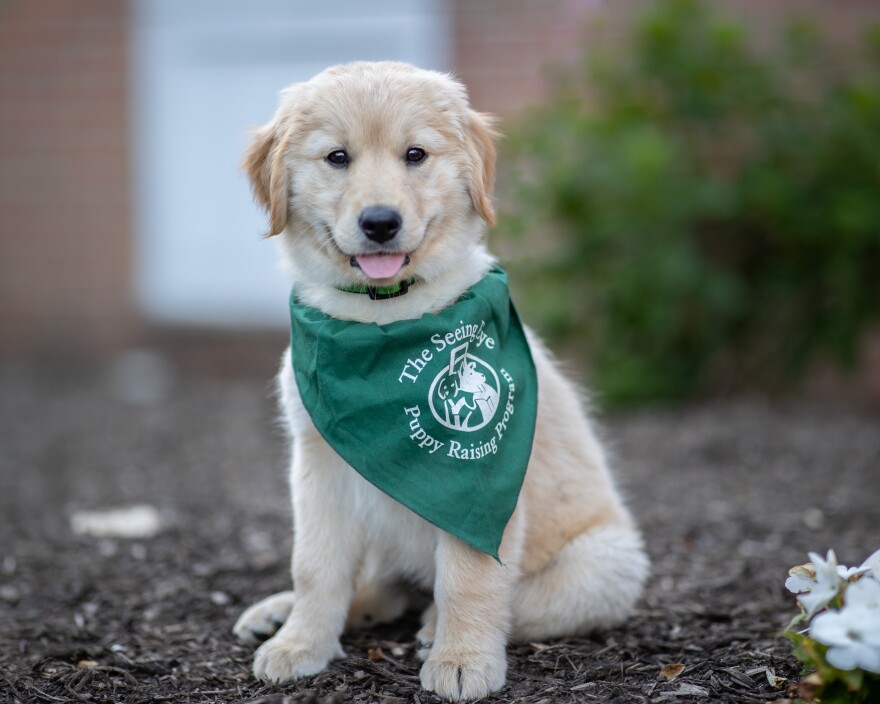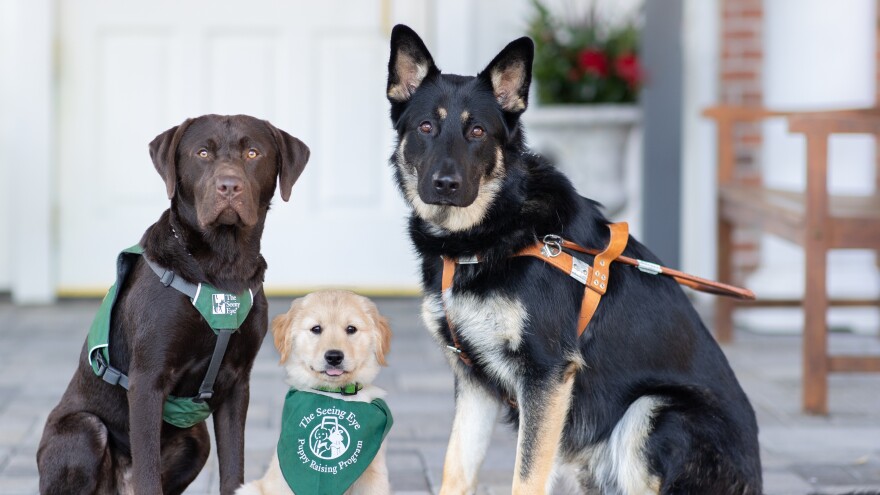MORRISTOWN, N.J. — Marlo, a German Shepherd puppy, could be heard softly whining in the background.
Dog lovers are familiar with the high-pitched, but adorable noise that came only come from a young pet—Marlo's way of telling Lauren Christie, it was time for a potty break.
Christie is in charge of the early stages of Marlo's life.
An assistant director of canine development at the Seeing Eye, Christie is also one of the organization's volunteer puppy raisers — members of the community who made a one-year pledge to teach the soon-to-be guide dogs basic obedience and work on their social skills.
The Seeing Eye, an organization that provides seeing eye dogs to visually impaired individuals, is currently accepting applications for volunteer puppy raisers who reside in the Lehigh Valley.
Perfect for first-time dog owners
According to Christie, the puppy raiser role is a fit for anyone including retirees, families, couples, working professionals, and those living alone.
It's also a role suitable for those who have never owned a dog, since puppy raisers learn a lot about responsibility, even if it's only for 12 months.
"Maybe you might move in the future, or you don't know where your life's going to be, you may be young, you don't know if you're going to have children or if your job's going to take you somewhere," she said.
"It's also a perfect opportunity if you never had a dog before, since it's a great way to kind of test it out, because puppy raisers get a ton of support through the organization and through the club dynamic."

Once puppy raisers fill out an initial application, volunteers are required to attend a series of training classes before they bring their new friend home.
"Before the puppy raisers get their puppy, they will have to puppy sit once or twice, usually with someone from their local club that they've met at the club meetings, Christie said.
"Then while they wait for the puppy, they'll still attend club meetings and practice handling dogs."
"It's really nice, because there's a sense of community that I think we've lost these days, like-minded people who all want to be puppy raisers, they love dogs, they want to help people, they want to do something good in the world."Lauren Christie, The Seeing Eye
Throughout the 12 months, they are matched with guidance counselors, or area coordinators, which act as liaisons between the Seeing Eye and the puppy raisers.
24/7 puppy support
The Seeing Eye puppy experts live nearby and offer guidance, answer questions, and lead the monthly club meetings with other puppy fosters.
"The clubs are comprised of local families in your county that meet once or twice a month," Christie said. "If you have questions, if something's happening with your puppy that you don't really know what to do, you have a group of people that you can reach out to. For instance, a lot of people wonder what to do if they go on vacation, chances are someone in the group will offer to puppy sit."
Community involvement is good for both puppies and foster parents.
"It's really nice because there's a sense of community that I think we've lost these days, like-minded people who all want to be puppy raisers, they love dogs, they want to help people, they want to do something good in the world," Christie said.
Puppy raisers also receive a quarterly stipend for supplies like food, toys and bedding and have access to a team of veterinarians should a medical issue arise (cost for medical visits are paid by the Seeing Eye).
The dogs stay with their raisers until they are about 12 - 15 months old.
While they are encouraged to stay off furniture, bark, or chew (a list of dos and don'ts is provided), it's suggested they receive a lot of exercise and love.
"The puppies get to play just like a regular dog. They'll play with your pets, your kids, at home. We, of course, want to discourage things like the biting and the nipping of hands and such, but they can get silly and let loose in fact, that's great that they do that, because when they're older as guide dogs, when the harness comes off, they're a dog again," Christie said.
Labs, Golden retrievers

The Seeing Eye breeds its puppies in Chester, New Jersey, about thirty minutes from its headquarters in Morristown, New Jersey.
"The types of dogs that we breed are Labradors, Golden Retrievers, German Shepherds, and we cross the Labradors and the Golden Retrievers," Christie said.
"People can decide if they want to choose one or the other, but it really helps us out more if you're a little bit more open. All of the dogs are wonderful."
After the year is up, the dogs arrive at headquarters to undergo a rigorous medical check-up and then start their guide dog training.
"The formal training is where they learn how to do the actual guiding work. Puppy raisers are just teaching the basic obedience and they're socializing them, so they're taking them out to public with permission, getting them used to the places that they're going to be working in as a future guide dog," Christie said.
Training for guide dogs includes learning how to walk on a special harness, and then later, participate in blindfold tests where the trainers walk with the dogs blindfolded.
"Once they complete their final blindfold and they pass it, they can be qualified to be matched with somebody," Christie said of the dogs, which by that time are typically two to three years old.
Chance for re-adopt, finding closure
Since the organization was founded in 1929, there have been more than 18,000 partnerships between people and guide dogs
Though not all of the dogs don't graduate from training —around 30 percent don't pass.
"It's a nice piece of closure that you get to see your dog doing its work, knowing that it will help someone in life."Lauren Christie, The Seeing Eye
"If they don't make it and they are released from the program for whatever reason, the puppy raisers will be the first person we call and ask if they would like to adopt free of charge," Christie said.
For the lucky dog who graduates, the puppy raiser, or raisers, are invited back to the Seeing Eye where they'll get to see the puppy-turned-service worker.
"Once the dog is almost all the way through their training, they're actually invited to watch the dog work and harness with their trainer," Christie said. "It's a nice piece of closure that you get to see your dog doing its work, knowing that it will help someone in life."
Puppy raisers also receive a letter and photo of their one-time puppy.
The letter gives general information about who they went to without sharing anyone's names, to respect privacy," Christie said. "It's a nice letter telling them about what their life's going to be like and a photo of them in harness."
For information on how to become a puppy raiser or volunteer with The Seeing Eye,visit their website.


